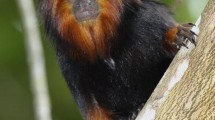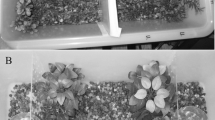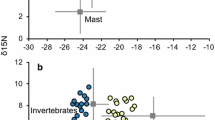Abstract
The relative roles of kinship and familiarity in affecting an individual’s growth and fitness are not easy to disentangle. Not only is an individual more likely to have prior behavioral interactions with conspecifics in close proximity, it may also be related (in terms of kinship) to those nearby conspecifics. While some studies have inferred that kin discrimination affects fitness correlates, other studies found that familiarity alone can reduce aggressive interactions, thus increasing fitness. These studies have all focused on intra-age class pairs or groups. However, many animals interact with conspecifics from different cohorts. In many populations, adults of Plethodon cinereus territorially defend rocks and logs that retain moisture and food resources. We investigated whether juveniles of P. cinereus grew more in the presence of adults that were relatives or familiar. We collected pairs of juveniles and adults found under the same cover objects in the forest (familiar) and pairs of juveniles and adults found under different cover objects, approximately 10 m apart (unfamiliar). We determined parentage and relatedness of the adult–juvenile pairs and then placed these pairs in semi-natural mesocosms for 17 days. We found that juveniles housed with familiar adults had significantly greater increases in mass and snout–vent length than juveniles housed with unfamiliar adults in 2006 but not in 2007. Relatedness had no effect on growth. In addition, juveniles cohabitating with adults were not more likely to be their offspring. At least under certain environmental conditions, familiarity with adults, independent of relatedness or parentage, increased the growth of juvenile salamanders.


Similar content being viewed by others
References
Adams E, Jones AG, Arnold SJ (2005) Multiple paternity in a natural population of a salamander with long-term sperm storage. Mol Ecol 14:1803–1810
Alberts SNB (1999) Paternal kin discrimination in wild baboons. Proc R Soc Lond Ser B, Biol Sci 266:1501–1506
Arnold SJ (1988) Quantitative genetics and selection in natural populations: Microevolution of vertebral numbers in the garter snake Thamnophis elegans. In: Weir B, Eisen E, Goodman M, Namkoong G (eds) Proceedings of the Second International Conference on Quantitative Genetics. Sinauer, Sunderland, MA, pp 619–636
Bekoff M (1981) Mammalian sibling interaction: Genes, facilitative environments, and the co-efficient of familiarity. In: Gubernick D, Klopfer P (eds) Parental Care in Mammals. Plenum, New York, pp 307–346
Beletsky L, Orians GH (1989) Familiar neighbors enhance breeding success in birds. Proc Nat Acad Sci USA 86:7933–7936
Bell A, Sih A (2007) Exposure to predation generates personality in threespined sticklebacks (Gasterosteus aculeatus). Ecol Lett 10:828–834
Blaustein AR, Porter RH (1990) The ubiquitous concept of recognition with special reference to kin. In: Bekoff M, Jamieson D (eds) Interpretation and explanation in the study of animal behavior volume I: interpretation, intentionality, and communication. Westview, Boulder, Colorado, pp 123–148
Blaustein AR, Bekoff M, Daniels TJ (1987) Kin recognition in vertebrates (excluding primates): empirical evidence. In: Fletcher DJC, Michener CD (eds) Kin recognition in animals. John Wiley, London, U. K., pp 287–331
Brown GE, Brown JA (1996) Does kin-biased territorial behavior increase kin-biased foraging in juvenile salmonids? Behav Ecol 7:24–29
Buesching C, Waterhouse J, MacDonald D (2002) Gas chromatographic analyses of the subcaudal gland secretion of the European badger. J Chem Ecol 28:41–56
Cabe PR, Page RB, Hanlon TJ, Aldrich ME, Marsh DM (2007) Fine-scale population differentiation and gene flow in a terrestrial salamander (Plethodon cinereus) living in continuous habitat. Heredity 98:53–60
Connors LM, Cabe PR (2003) Isolation of dinucleotide microsatellite loci from the red-backed salamander (Plethodon cinereus). Mol Ecol Notes 2003:131–133
Dantzer B, Jaeger R (2007) Detection of the sexual identity of conspecifics through volatile chemical signals in a territorial salamander. Ethology 113:214–222
Dawley E (1984) Recognition of individual, sex and species odors by salamanders of the Plethodon glutinosus-Plethodon jordani complex. Anim Behav 32:353–361
Dingemanse N, Both C, Drent P, van Oers K, van Noordwijk A (2002) Repeatability and heritability of exploratory behaviour in great tits from the wild. Anim Behav 64:929–938
Fontaine PM, Dodson JJ (1999) An analysis of the distribution of juvenile Atlantic salmon (Salmo salar) in nature as a function of relatedness using microsatellites. Mol Ecol 8:189–198
Gibbons ME, Ferguson AM, Lee DR, Jaeger RG (2003) Mother–offspring discrimination in the red-backed salamander may be context dependent. Herpetologica 59:322–333
Gillette JR, Peterson MG (2001) The benefits of transparency: candling as a simple method for determining sex in red-backed salamanders (Plethodon cinereus). Herpetol Rev 32:233–235
Goodnight KF, Queller DC (1998) RELATEDNESS 5.08. http://www.gsoftnet.us/GSoft.html
Goodnight KF, Queller DC (1999) Computer software for performing likelihood test of pedigree relationship using genetic markers. Mol Ecol 8:1231–1234
Griffiths SW, Magurran AE (1997) Familiarity in schooling fish: how long does it take to acquire? Anim Behav 53:945–949
Hain T, Neff B (2007) Multiple paternity and kin recognition mechanisms in a guppy population. Mol Ecol 16:3938–3946
Hamilton WD (1964a) The genetical evolution of social behaviour I. J Theor Biol 7:1–16
Hamilton WD (1964b) The genetical evolution of social behaviour II. J Theor Biol 7:17–52
Hansen M, Nielson E, Mensberg K (1997) The problem of sampling families rather than populations: relatedness among individuals in samples of juvenile brown trout Salmo trutta. Mol Ecol 6:469–474
Holmes WG (1986) Identification of paternal half-siblings by captive Belding’s ground squirrels Spermophilus beldingi. Anim Behav 34:321–327
Holmes WG, Sherman PW (1982) The ontogeny of kin recognition in two species of ground squirrels. Am Zool 22:491–517
Jaeger RG (1981) Dear enemy recognition and costs of aggression between salamanders. Am Nat 117:962–974
Jaeger RG (1984) Agonistic behavior of the red-backed salamander. Copeia 1984:209–314
Jaeger RG, Wicknick JA, Griffis MR, Anthony CD (1995) Socioecology of a terrestrial salamander: juveniles enter adult territories during stressful foraging periods. Ecology 76:533–543
Jones AG (2001) GERUD 1.0: A computer program for the reconstruction of parental genotypes from progeny arrays using multilocus DNA data. Mol Ecol Notes 1:215–218
Jones AG, Ardren WR (2003) Methods of parentage analysis in natural populations. Mol Ecol 12:2511–2523
Komdeur J, Hatchwell B (1999) Kin recognition: function and mechanisms in avian societies. Trends Ecol Evol 14:237–241
Leclair M, Levasseur M, Leclair R Jr (2006) Life history traits of Plethodon cinereus in the northern parts of its range: Variations in population structure, age and growth. Herpetologica 62:265–282
Liebgold EB, Jaeger RG (2007) Juvenile movements and potential inter-age class associations of red-backed salamanders. Herpetologica 63:51–55
Liebgold EB, Cabe PR, Jaeger RG, Leberg PL (2006) Multiple paternity in a salamander with socially monogamous behaviour. Mol Ecol 15:4153–4160
Mateo J, Holmes WG (2004) Cross-fostering as a means to study kin recognition. Anim Behav 68:1451–1459
Mathis A (1990) Territoriality in a terrestrial salamander: the influence of resource quality and body size. Behaviour 112:162–175
Mathis A (1991) Territories of male and female terrestrial salamanders: costs, benefits, and intersexual spatial associations. Oecologia 86:433–440
Mathis A, Jaeger RG, Keen WH, Ducey PK, Walls SC, Buchanan BW (1995) Aggression and territoriality by salamanders and a comparison with the territorial behaviour of frogs. In: Heatwole H, Sullivan BK (eds) Amphibian biology. Surrey Beatty and Sons, Chipping Norton, New South Wales, pp 633–676
Mjolnerod I, Refseth U, Hindar K (1999) Spatial association of genetically similar Atlantic salmon juveniles and sex bias in spatial patterns in a river. J Fish Biol 55:1–8
Myers EM, Zamudio KR (2004) Multiple paternity in an aggregate breeding amphibian: the effect of reproductive skew on estimates of male reproductive success. Mol Ecol 13:1951–1963
Ng MY, Wilbur HM (1995) The cost of brooding in Plethodon cinereus. Herpetologica 51:1–8
O’Hara RK, Blaustein AR (1982) Kin preference behavior in Bufo boreas tadpoles. Behav Ecol Sociobiol 11:43–49
Perrin N, Lehmann L (2001) Is sociality driven by the costs of dispersal or the benefits of philopatry? A role for kin-discrimination mechanisms. Am Nat 158:471–483
Petranka JW (1998) Salamanders of the United States and Canada. Smithsonian, Washington, DC
Peuhkuri N, Seppa P (1998) Do three-spined sticklebacks group with kin? Ann Zool Fenn 35:21–27
Pfennig DW (1990) ‘Kin recognition’ among spadefoot toad tadpoles: a side effect of habitat selection? Evolution 44:785–798
Raymond M, Roussett F (1995) GENEPOP (version 1.2): a population genetics software for exact tests and ecumenicism. J Hered 86:248–249
SAS Institute Inc. (2004) SAS version 9.1. http://support.sas.com/onlinedoc/913/docMainpage.jsp. Cary, North Carolina
Sayler A (1966) The reproductive ecology of the red-backed salamander, Plethodon cinereus, in Maryland. Copeia 1966:183–193
Secor S, Boehm M (2006) Specific dynamic action of ambystomatid salamanders and the effects of meal size, meal type, and body temperature. Phys Biochem Zool 79:720–735
Tang-Martinez Z (2001) The mechanisms of kin discrimination and the evolution of kin recognition in vertebrates: a critical re-evaluation. Behav Processes 53:21–40
Todrank J, Busquet N, Baudoin C, Heth G (2005) Preferences of newborn mice for odours indicating closer genetic relatedness: is experience necessary? Proc R Soc Lond Ser B, Biol Sci 272:2083–2088
Wade MJ, Breden F (1981) Effect of inbreeding on the evolution of altruistic behavior by kin selection. Evolution 35:844–858
Ward AJ, Hart PJ (2003) The effects of kin and familiarity on interactions between fish. Fish Fish 4:348–358
Ward AJ, Hart PJ, Krause J (2004) The effects of habitat- and diet-based cues on association preferences in three-spined sticklebacks. Behav Ecol 15:925–929
Watson A, Moss R, Parr R, Mountford MD, Rothery P (1994) Kin landownership, differential aggression between kin and non-kin, and population fluctuations in red grouse. J Anim Ecol 63:39–50
Widdig A (2007) Paternal kin discrimination: the evidence and likely mechanisms. Biol Rev 82:319–334
Yurewicz K, Wilbur HM (2004) Resource availability and costs of reproduction in the salamander Plethodon cinereus. Copeia 2004:28–36
Acknowledgments
We thank Butch Brodie, Henry Wilbur, and Eric Nagy of Mountain Lake Biological Station (MLBS) for the use of the facilities. We thank Alex Roberts and Britt Ousterhout for assistance with setting up the mesocosms and collecting salamanders. We also thank Kelly Hemminger and Molly Potempkin for invaluable work in the laboratory. Dan Sloan and Stephen Keller provided assistance with the use of the ABI 3130 and Genemapper. Comments from Tami Ransom, Butch Brodie, Janis Antonovics, David Carr, and two anonymous referees greatly improved the quality of this manuscript. EBL was supported by a Presidential Fellowship at the University of Virginia (UVA) while working on this study. MLBS provided Research Fellowships in the summers of 2006 and 2007. Funding for laboratory work was provided by NSF DEB-0235695 to David Marsh and PRC. Fieldwork was conducted under Virginia Department of Game and Inland Fisheries permit nos. 026019 (2006) and 030986 (2007) and ACUC Protocol No. 3581, which was approved by the UVA Animal Care and Use Committee.
Author information
Authors and Affiliations
Corresponding author
Additional information
Communicated by J. Christensen-Dalsgaard
Rights and permissions
About this article
Cite this article
Liebgold, E.B., Cabe, P.R. Familiarity with adults, but not relatedness, affects the growth of juvenile red-backed salamanders (Plethodon cinereus). Behav Ecol Sociobiol 63, 277–284 (2008). https://doi.org/10.1007/s00265-008-0659-4
Received:
Revised:
Accepted:
Published:
Issue Date:
DOI: https://doi.org/10.1007/s00265-008-0659-4




